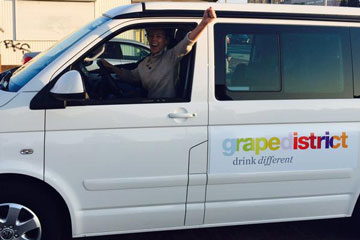*Online Marketing
Joint promotion: two brands growing together

Finding new potential customers is perhaps the most common question posed to marketers. The pond from which companies have been fishing for years is “good enough,” but that extra growth isn’t found there. So where is it found?
You could spend a lot of money on advertising or exhibit at a new trade fair, but how do you reach new customers on a tighter budget? Joint promotion might just be the right answer. For Volkswagen Campers, we recently laid the foundation for a successful joint promotion campaign. Using this example, we’ll explain what joint promotion entails, how to set up such a campaign, and why it’s important for brands to “fall in love” with each other.
The goal was simple: to bring the ‘VW Camper’ lifestyle to the attention of more people. We have a strong bond with our target group, our fans, and have been able to enthuse these people for years. But how can we confront more people with the joys of going on holiday with a VW camper? It was time to start ‘preaching outside of our own parish.’ We quickly realized that we didn’t want to buy a very high reach through expensive campaigns but wanted to do this in a ‘smarter’ and ‘more fun’ way. Thus, we set ourselves the goal of generating the right attention on a limited budget.
Joint Promotion: Generating a Lot of Attention on a Limited Budget
After inventorying best practices and brainstorming, we had a stack of ideas but also realized that we might not be the only brand facing this challenge! Aren’t there companies we can collaborate with? The idea of joint promotion was born. But which brands are a good fit for VW? We looked for brands that shared our values, whose target group matches or complements ours, and an organization that is ‘free’ enough to work on something really different. In short, a brand we could fall in love with as a brand ourselves. And we found one.
Falling in Love
At the top of our list was Grape District, a young and fresh Dutch wine company that does things a bit differently. We made an initial approach and soon sat down together to think about possible actions. In this meeting, we determined that both brands enjoy creating fun content for their followers, and that campers, camping, and wine are closely related for many people. It was a logical step to bring these elements together literally, and the idea for the wine road trip was born. But which action would best bring this to attention?
Choosing the Right Action
We decided to link it to something tangible; with the purchase of a bottle of wine, customers received a card they could fill out to enter the contest. This way, we got participants who genuinely loved wine and made the result immediately tangible. The winner will take three friends on this delightful journey. During the trip, they are followed by a cameraman, and we report on the different social media channels through photos and stories. The launch of the action, the prize, the winner, the ‘live’ report of the road trip, and the final video were all fun contact and content moments that led to high engagement. A huge success!
Using Joint Promotion as a Marketing Tool
Joint promotion allows companies to leverage each other’s strengths to grow together but is often seen as ‘far from bed’ for many brands. Especially in a time when people ‘like’ brands or become fans, it is quite possible to make very natural connections. In this example, we effectively connect a camper to a bottle of wine, but the connecting factor is not the product but the target group! Camping and wine are so closely related that these two brands can be too.
This question is one you can also ask yourself: what other brands or products does my target group use that actually fit very well with mine? Apple and Nike helped people run better together, and Lego allowed children to play with real Star Wars characters. We can’t imagine that there are no ‘logical’ partners you could think of for a collaboration with your brand. How such a collaboration would look comes later; first, think about which brand you could fall in love with. Do you see opportunities for a joint promotion with your brand, or have you already done something? Tell us all about it!
